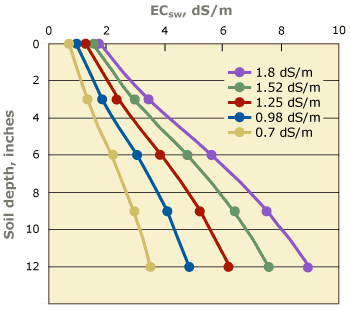- Home
- Learn about salinity
- Get to know your site
- Design a landscape
- Solve a problem
- Other information
Salinity Management Guide
Managing soil salinity
Management option: Blending of waters

Figure 11. Salt profiles for the root zone of a cool season turfgrass irrigated with saline water of EC 1.8 dS/m, at LF of 0.2, and blended with less saline water of EC 0.7 dS/m in various proportions (25% = 1.52 dS/m, 50% = 1.25 dS/m, 75% = 0.98 dS/m).
Figure 11 depicts the salinity profile for irrigation of a cool season turfgrass with water having ECiw of 1.8 dS/m. The leaching fraction for this case is 0.2. Using the graph, one can estimate that the average ECsw in the root zone is 5.5 dS/m. Since the threshold salinity for this cool season turfgrass is ECe of 1.5 dS/m (or ECsw of 4.1 dS/m), the water is too saline. (The threshold salinity is the average root-zone salinity above which a plant will begin to suffer.)
Assume that a water having EC of 0.7 dS/m is available for blending. The combining, via blending, of less saline water with saline water in proportions of 25%, 50% and 75% will give blended waters having EC of 1.5, 1.25, or 0.98 dS/m, respectively.
The accumulation of salt in the root zone when irrigating at a leaching factor of 0.2 is shown in the figure for each of the three blended waters, as well as for the high-salt (1.8 dS/m) water and the low-salt (0.7 dS/m) water. For soil depths up to 6 inches, the 50% and 75% blends both meet the criterion of providing an ECsw of 4.1 dS/m. This is sufficient for shallow rooted grasses. For depths from 6 to 9 inches, of the blends, only the 75% mixture (75% low-salt water to 25% higher-salt water) will suffice. For soil depths greater than 9 inches, only the low-salt water (0.7 dS/m) will do.
| « Previous page | Next page » |